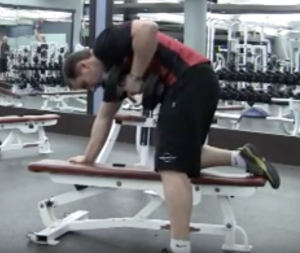3 Common Movement Faults & How to Fix Them
Today I have a guest post from another Canadian, Gavin McHale. I think you’ll get a lot out of his writing style and delivery.
*****
It happens all the time… I go into public gyms with a beginner’s mindset, but it’s inevitable that I see something that makes me want to rip my eyeballs out.
Even new clients don’t have any frame of reference for how a movement should look or feel. Many people get away with poor movement for whatever reason, but others don’t. They end up feeling sore in the wrong places, leading to confusion and injury that may keep them out of the gym for good – not something we want to see.
“Everything works… until it doesn’t.” – Kelly Starrett
So I compiled a short list of movement faults that people tend to repeat. Who knows where they come from. Hello Jillian Michaels. Tracy Anderson anyone?
Image courtesy of liftingrevolution.com
The Lawn Mower
Many people believe that when they’re performing a single arm row, they need to pull their elbow to the high heavens to get an effect. But what happens when they do this and how does it affect their joints?
Inevitably, the shoulder rolls into internal rotation because they do not have the requisite mobility and the upper traps turn on, making them feel like they’re pulling with their neck and often leading to headaches. Furthermore, most people can’t properly get their lats to fire without coaching.
A poor position may also be more comfortable for many clients and you may even notice them slip into it after a few good reps. People tend to be more comfortable with a rounded thoracic spine and think this exercise focuses on the biceps, since that’s what is actually moving.
Our job is to reverse those thought processes, so we have to change our language.
The old “pull like you’re starting the lawn mower” has to go. The slightly newer “pull the weight to your hip” doesn’t work too well either, as it actually promotes internal rotation of the shoulder. So what should we say? I’ve found success with the following cues:
- Puff your chest out.
- Shoulder-blade into the back pocket (often placing my hand on their scap and making the motion towards the middle of their back).
- Squeeze your armpit like you’re holding a $100 bill in there.
- Your shoulder and your ear shouldn’t be friends
- Pull your shoulder back in the socket. NOTE: This cue is highly internal and may not work for a lot of people, but the jist of it is that we’re trying to take the focus off the elbow and place it onto the shoulder.
I’m sure there are many more cues that work (please comment) but the goal is to get the lats doing the work and enforce good posture and controlled movement.
The Knee Drive
When I see people lunge for the first time – or they forget what I’ve told them – it’s easy to see why they experience knee pain during the movement. If someone tells me they’ve been told not to lunge or have decided that “lunges hurt”, I take that as a challenge.
Let’s start by looking at what’s happening in the knee joint during a forward lunge. First of all, a step of that magnitude causes a greater knee moment than a backwards step. This is thought to cause an anterior glide of the femur in relation to the tibia, causing a stretch of the patellar tendon and the connective tissues surrounding it. That, and the deceleration forces needed to stop the femur from gliding too far team up to create HUGE stress on the knee joint.
Image courtesy of imgflip.com
Bret Contreras also pointed out a 2012 study that broke down the force placed on both the ACL and PCL during a forward lunge. The study discovered that there was surprisingly more force placed on the PCL (647lbs at the bottom of the lunge) but a figure showed high amounts of shear force on the knee throughout the movement, which I think is important regardless of the mechanism. You can check out Bret’s article HERE and see the whole research study HERE.
Finally, our society that exacerbates the fact that most people can’t even activate their glutes. Constant sitting (in poor positions) and shoes that prop us up onto our toes (you too, gents) create anterior dominant systems. When this happens, the quads tend to take on most of the load, allowing the posterior chain off the hook, which further compounds the issue of improper force distribution on the knee joint.
There are numerous different options to keep cranky knees happy during single leg work. We can hit reverse lunges, split squats, rear-foot-elevated split squats or even single leg squats to a bench. When moving to forward lunges, I have come up with an incredibly scientific saying.
Step, Stop, Drop & Pop
Step: Take the big step into a lunge position.
Stop: Stop forward momentum (to stop the shear force placed on the knee). This must be continuously repeated as people tend to want to slide forward, particularly when fatigued.
Drop: Drop into the front heel, allowing them to load up the hips and posterior chain.
Pop: Pop forward onto the front foot. To avoid that lead knee dropping into a valgus position, you can also encourage them to keep the knee above the shoelaces.
Ideally, the front knee does not pass the front toe and the back knee should get to about an inch from the floor.
There are certainly other ways to get the same result, but let’s remember that the goal is to improve stability in the quads, hamstrings and glutes, not drive the knee into oblivion.
Ass to Grass
When new consults come see me about issues with their squat, they inevitably “drop it like it’s hot”, completely disregarding form, tension, hip and back positioning.
Yuh, that’s going to hurt your back… or your knees… or everything. And I can’t unsee that.
I get it. Going ass to the grass looks pretty badass. But it is not for everyone. Just like this song.
Dean Somerset has written several articles on the topic of anatomical differences in the hip and their pertinence to the ability to get into certain positions, so I won’t attempt to recreate them. Click HERE for one of his best.
The problem here is twofold. People are watching videos online (and Crossfit and Olympic weightlifting on TV) and seeing everyone get low, and some trainers are preaching that EVERYONE needs to get their booties damn near the floor.
First of all, athletes who can go ass to grass are blessed with the anatomy that allows them to do so. This is part of the reason they’re successful in the first place.
Second, a trainer who forces everyone into the same squat position is like a mechanic fixing every car – regardless of the make and model – with the same parts. Square peg, round hole.
A squat, first and foremost, should be pain free. If someone is feeling pain during squats on a regular basis, they should go see a licensed therapist or properly certified strength coach who can find the squat that fits their body.
For the most part, the lower back should maintain a slight arch. The torso and lower leg should be at approximately the same angle when looking at the squat from the side. The knees should stay over the shoelaces or wider at all points in the movement when looking at it from straight ahead.
I wrote an article on fixes for squat faults. If someone’s squat looks or feels a little “off”, take a look HERE and see if they fit the bill for any of the faults.
Also, here are the 3 best ways I’ve found to improve squat depth in those who want to go deeper but seem stuck.
- Reduce stress on the ankle joint. If everything looks good but the torso is at a different angle from the lower leg, I’ll prop their heels on small plates. Over time, we will further address the ankle mobility issue.
- Improve core stability. You would think this would take some time, and it probably will. But adding a load to the front of the body (such as a kettlebell in the goblet position), forces the core to fire and moves the centre of gravity back, allowing more depth in the squat.
- Improve thoracic mobility. Our lifestyles affect our posture to a point where it negatively affects our movement. A bit of foam rolling and thoracic extension work often allows people to stay taller and sit deeper in their squat without compensating somewhere along the way.
So there you have it. Three movement faults that many people still can’t kick and how we can help fix them. Please comment with other tips and tricks you’ve found helpful, I’m always looking to improve my arsenal.
About the Author
Gavin McHale CSEP-CEP
Gavin is the Professional Development co-chair of the Manitoba Kinesiology Association, a Certified Exercise Physiologist, and goalie coach at Richard Burr Fitness in Winnipeg, Manitoba. See more of him at www.gavinmchale.com.




6 Responses to 3 Common Movement Faults & How to Fix Them